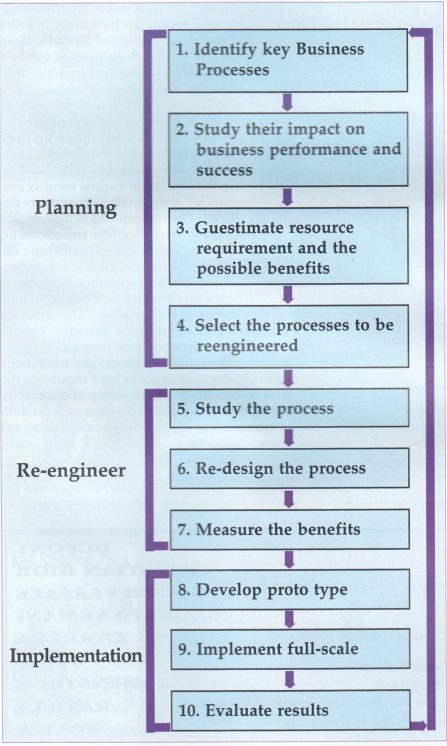Productivity through Reengineering
This is the second and final article in this series. In the last issue, we discussed how benchmarking can help to improve productivity. In this issue, we will see how Business Process Reengineering can play a major role in productivity improvement.
‘Let me revisit the definition of productivity according to John Heap, author of Productivity Management: A fresh approach’ says S Arunasalam.

The right process is the process that will produce maximum output, in terms of quantity and quality, with minimum input in terms of time and costs. Hence, the achievement of productivity improvement.
Redesigning the existing processes into the right processes to maximize productivity is Business Proc ess Reengineering (BPR).
Michael Hammer and James Champy, fathers of this concept define reengineering as:
“The fundamental rethinking and radical redesign of business processes to bring about dramatic improvements in performance.”
Hammer and Champy argue that radical redesign of processes is required to produce dramatic improvements quantum leaps – in performance which naturally includes productivity. Can all organizations undertake radical redesign? May be and may be not. Process reengineering, to achieve quantum leaps, is quite expensive (of course, the benefits may be many fold) and takes a significant amount of time. However, it is not a take it or leave it concept. It simply means that you have to rethink fundamentally the way you do business.
The organization can decide to redesign its processes in different scales, as some improvements will be better than no improvements. The scale of redesign can vary according to the commitment, affordability and complexity of the organization.
Approach
The following 10 Step Approach could be used in process re-engineering.

Planning
In the Planning stage, the major business processes are identified. It is essential that tasks are not mistaken for processes. Checking the available credit of a customer is one task in the order fulfilment process. Processes may cut across functional and departmental boundaries. It is the process that has to be redesigned; not the task.
Once the key processes are identified, their impact on the business success and performance must be studied. Some processes will impact more than the others depending on the business and environmental requirements of a company. These must be ranked.
The processes that are ranked high in Step 2 are selected and a guestimate of the resource requirements to redesign and the benefits and risks are considered.
Based on the evaluation carried out in the Steps 1 to 3, the processes to be reengineered are selected. Hammer suggests that unless all the key processes are reengineered, the reengineering exercise will not yield substantial benefits. But, as we discussed earlier, organization can undertake process redesign to even a single key process, if the resources are a constraint.
Reengineer
In the second stage, the processes that were selected for reengineering are studied and analyzed. The study and analyses must focus on the relevance of the output of that process in today’s context and should not focus too much on the process itself. There are two reasons. One is that it is very time consuming and it is not worth it as most tasks in the process are bound to be discarded. The other reason is that, creativity of the reengineering team might become low and they might start accepting the existing processes. Hammer advocates that redesigning must be done with the assumption that the company is just born. He believes in creativity more than anything. However, Robert Camp argues that benchmarking is an effective tool
for reengineering, and it eliminates the need of reinventing the wheel. Hammer’s response to this is that benchmarking must be done in a limited scale as benchmarking identifies the ‘existing’ best practice, but reengineering is aimed at new levels of perform ancequantum leaps.
After redesign is completed, expected benefits must be estimated, and the redesigned process must be accepted for implementation.
Implementation
As a first step in the implementation stage, a prototype of the redesigned process must be introduced. It may be introduced in a small section or a branch of the organization, and preferably run parallel to the old process, so that any problems can be identified and overcome. It will avoid any major disruption or disasters that can occur, when a new process is introduced and later found to be faulty.
If the prototype is found to be satisfactory, it can be extended to the whole organization. Here again, if the resources (mainly the skills for implementation) are limited, it can be done in phases. But, one should have in mind that every delay in implementing the new process contributes to loss of benefits.
Evaluation of the results of reengineering is essential to determine the success. If the results are positive, then it will be a great motivating factor to continue reengineering and search for excellence.
Sri Lankan scenario
In Sri Lanka, a few multinational companies and large local companies have already started reengineering. Although reengineering takes about two to three years to complete, many say that they already see positive signs of success. However, the pace at which reengineering is spreading, is not encouraging. The right kind of awareness is not there. Many still consider reengineering either as an academic exercise or as something that only very large companies can do. It is wrong.
Any organization can undertake reengineering. The productivity groups and quality circles within the organizations can undertake reengineering. Public sector can have huge benefits from reengineering and save a lot of tax payers’ money. Reengineering can be a truly motivational tool in many progressive organizations.
The downsizing and lay offs in many western companies during the recession are still shadowing any change initiatives including reengineering. This is more critical in a Sri Lankan context. In the absence of a social security system, lay offs and retrenchments are difficult. The companies will have to find ways of retraining and redeployment. However, it must be clear that the objective of a reengineering is not staff reduction. Many companies were able to grow much larger in business volume without any change in staff numbers. One financial institution was able to open new branches without recruitment after a reengineering program.
The government, trade chambers and institutions for higher education must strive hard to educate the managers on benefits of reengineering. It must be remembered that when the individual organization takes a quantum leap in performance, the country will follow suit.



